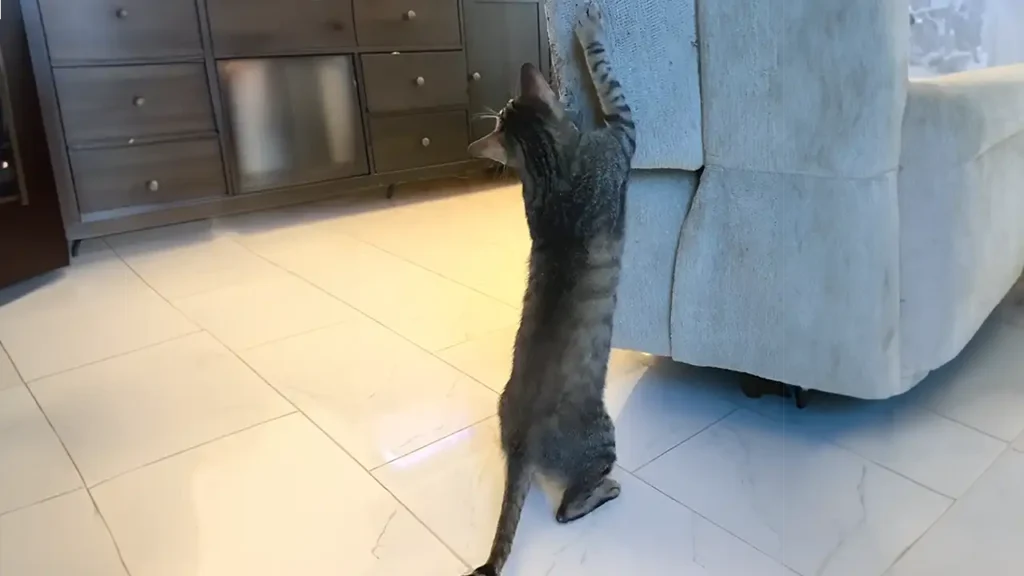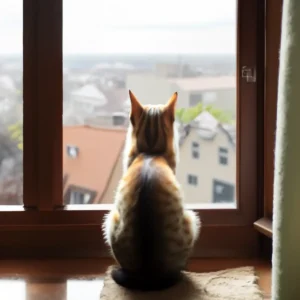Cats scratch walls for various physiological and behavioral reasons. While scratching is a natural feline instinct, it can damage furniture and annoy homeowners. This article explains the science behind cat scratching and provides tips for redirecting cats to appropriate scratching surfaces.
Table of Contents
Why Do Cats Scratch Walls?

Cats scratch walls for various reasons. It is a natural behavior that serves multiple purposes. Understanding why cats engage in this behavior can help owners address their needs and prevent damage to walls, among these reasons :
1- Maintaining Sharp Claws
Cats have an innate desire to keep their claws sharp and healthy. Their claws are made up of layers – an outer sheath protecting the solid nail underneath. As cats go about their daily activities, this outer layer slowly frays and splits. Scratching serves the important purpose of removing these worn outer layers to reveal fresh sharp claws.
Much like shedding fur or molting feathers, cats need to regularly “shed” the outer nail casings on their claws. This shedding process requires a rough abrasive surface that will catch and rip off the old sheaths. Scratching posts provide the ideal texture for cats to hook their curved claws into and strip away dead claw tips.
Without regular removal of fraying sheaths, cats’ claws can become blunt, thick, and painful. The old sheath simply builds up, smothering the pointed claw inside. Uncomfortable, overgrown claw capsules put pressure on cats’ sensitive nail beds. This is why frequent scratching to shed sheaths is vital for feline health and well-being, keeping claws permanently conditioned in an optimal sharp state. It serves an important physiological purpose similar to brushing our teeth – removing dead material to maintain strength and function.
2- Marking Territory
Cats also scratch to mark their territory. As they drag their claws down an object, scent glands on the undersides of their paws release secretions. These secretions contain pheromones that label the scratched area as the cat’s domain.
By leaving visual marks and facial pheromones on household surfaces, your cat is staking their claim and creating a feeling of security and ownership. Scratching announces a cat’s presence and establishes boundaries between their zone and the rest of the world. It serves as a form of feline communication regarding occupied areas.
3- Stretching and Exercise
In addition to claw conditioning and territorial labeling, scratching provides an excellent full-body stretch for cats. The action elongates the body, working various muscle groups in the legs, shoulders, lower back, and paws. Cats can scratch with one paw at a time or alternate between both front paws in a downward stretch.
Scratching is essentially a light workout for cats. The motion loosens up muscles, improves flexibility, and enhances overall fitness. After a good scratch, your cat likely feels more relaxed and energized. The activity also helps release pent-up energy in restless cats.
4- Expressing Emotions
For cats, scratching serves as more than physical maintenance and sensory marking – it also allows them to express their inner emotional state. By observing when, where, and how your cat scratches, you can gain insight into how they are feeling, In addition, the position and movement of their tail play a crucial role in conveying their emotions and intentions
A happy, content cat may leisurely scratch their scratching post after a satisfying meal or nap. This scratching indicates a relaxed, secure cat spreading their scent and stretching their claws casually. It reinforces their comfortable presence.
On the other hand, energetic scratching of walls and furniture can signify an aggravated cat. Faster-paced, frantic scratching coupled with restless body language is a red flag for anxiety, frustration, or anger in a cat. The act of digging claws vigorously into a surface helps them release tension.
Even subtle differences like the force and speed of scratching provide emotive clues. Pay close attention to any changes in your cat’s scratching habits. If their scratching shifts from their post to the couch when you have guests over, it likely indicates an overwhelmed cat. Try to minimize environmental stressors.
Understanding the strong link between clawing patterns and the inner psyche helps owners support their cat’s well-being. Providing suitable scratching outlets lets cats express themselves through scratching without damaging the furnishings.
Redirecting Scratching Behavior

The key to saving your furnishings from destructive cat scratching is providing designated scratching areas that appeal to their instincts. Strategically place cat scratching posts and pads around your home to divert attention from carpets, couches, and drapes onto surfaces created for clawing comfort.
Observe your cat’s scratching habits first to determine favored locations, textures, and scratching angles. Do they stretch vertically on the couch or scratch horizontally on the rug? Providing suitable scratchers that match their style in key areas makes redirection easier.
Scratching posts come in all shapes, sizes, and material textures. Try different varieties like sisal rope, corrugated cardboard, woven seagrass, or simple wood posts to discover preferences. Angle some vertically for full-body stretching and lay others flat on the floor to satisfy horizontal scratching.
You can also entice your cat towards appropriate scratchers by sprinkling them with catnip or attaching toys and treats. Praise and treat your cat when they use their cat scratching posts so they learn that is where scratching is approved. With some patience and experimentation, you can redirect those sharp claws away from your belongings.
Conclusion
In closing, scratching is essential for cats to maintain sharp claws, mark territory, stretch their bodies, and express emotions. As frustrating as it may be, try not to admonish natural scratching behavior. Instead, provide inviting vertical and horizontal cat scratching posts to redirect claws away from your valuables.
Cater scratching tools to your cat’s preferences for location, texture, and scratching angle based on their habits. Use catnip, treats, toys, and praise to entice them to scratch where you want them to. With time and positive reinforcement, you and your cat can peacefully coexist – saving your sofa and satisfying feline instincts.
Understanding the meaning behind scratching allows owners to address cats’ fundamental needs while protecting their furnishings. Provide suitable scratching outlets, observe clues, and gently redirect to harness scratching for harmonious human-feline relationships.
FAQS
Why do cats scratch doors at night?
Cats scratch doors at night for a variety of reasons. They may be bored and looking for interaction or playtime. Their natural hunting instincts could also kick in if they hear sounds behind the door, triggering their prey drive. Cats may also scratch due to anxiety from being separated from their owners overnight. Marking territory and looking to explore new areas are additional explanations for this common feline nighttime behavior.
Meeting their needs for play and affection by day can head off disruptive scratching when we head to bed. Understanding what makes our cats tick can lead to more restful nights for pets and owners alike.
Why does my cat scratch the side of the litter box?
It’s not unusual for cats to scratch the sides of their litter box. This behavior stems from a cat’s natural instinct to cover up their waste. In the wild, cats would scratch the soil and leave over their feces and urine to mask the scent from potential predators. Even domesticated house cats retain this instinctual scratching behavior. Scratching the walls of the litter box is your cat’s way of trying to “bury” their business, even if no soil or litter is there.
Some cats may also scratch to mark their territory, claiming ownership over the litter box by leaving visual and scent cues from their paws. If your cat is scratching the litter box frequently or aggressively, make sure the box is cleaned regularly and filled with enough litter so your cat can exhibit its natural scratching behavior.
You may also need to provide a larger box so there is ample space for scratching without spilling litter onto the floor. Satisfying your cat’s instincts will keep both your cat and its litter box happy.
Why does my cat scratch the wall instead of litter?
Cat scratches wall and other surfaces to mark territory and sharpen their claws. When a cat scratching the wall rather than digging in the litter, it usually means the litter box is unsatisfactory. Reasons may include an insufficient amount of litter, infrequent scooping resulting in a dirty box, or the litter box itself may be too small or uncomfortable. Sometimes stressful situations like changes in the home or the introduction of new pets can also cause unusual scratching. Providing a clean, roomy litter box with enough litter to allow natural digging and covering behaviors is key to redirecting scratching to appropriate places.
How to stop cats from scratching walls?
There are several effective methods to stop cats from scratching walls and furniture. Providing appropriate cat scratching posts and boards around the house is crucial – these give cats an outlet for their natural scratching instinct.
Sites like walls and furniture often get scratched when cats don’t have suitable places to scratch. Another useful approach is to use deterrent sprays which have mild scents cats dislike. Applying these on walls and furniture can discourage scratching.
Finally, using soft plastic nail caps on cats can reduce damage if they scratch on inappropriate areas. With a combination of these measures – providing suitable scratching areas, using deterrent sprays, and nail caps – destructive scratching can be significantly reduced. The key is addressing natural feline behavior and redirecting scratching to appropriate designated areas.


